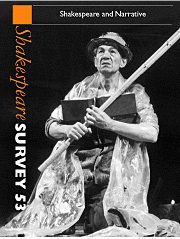Book contents
- Frontmatter
- Shakespeare’s Narremes
- Stepping Out of Narrative Line: A Bit of Word, and Horse, Play in Venus and Adonis
- A ‘consummation devoutly to be wished’: The Erotics of Narration in Venus and Adonis
- Echoes Inhabit a Garden: The Narratives of Romeo and Juliet
- A Midsummer Night’s Dream: Comedy as Apotrope of Myth
- Plutarch, Insurrection, and Dearth in Coriolanus
- Shakespeare, Crossing the Rubicon
- Vernacular Criticism and the Scenes Shakespeare Never Wrote
- The Shadow of Lear’s ‘Houseless’ in Dickens
- Shakespearian Margins in George Eliot’s ‘working-day world’
- In Her Father’s Library: Margaret Fuller and the Making of the American Miranda
- The Magician in Love
- Narrative Approaches to Shakespeare: Active Storytelling in Schools
- Monsters, Magicians, Movies: The Tempest and the Final Frontier
- Shakespeare’s Self-Repetitions and King John
- Inside Othello
- The View of London from the North and the Playhouses in Holywell
- Measured Endings: How Productions from 1720 to 1929 Close Shakespeare’s Open Silences in Measure for Measure
- Shakespearian Utopias
- Shakespeare Performances in England, 1999
- Professional Shakespeare Productions in the British Isles January–December 1998
- The Year's Contributions to Shakespearian Study 1 Critical Studies
- 2 Shakespeare’s Life, Times, and Stage
- 3 Editions and Textual Studies
- Books Received
- Index
Echoes Inhabit a Garden: The Narratives of Romeo and Juliet
Published online by Cambridge University Press: 28 March 2007
- Frontmatter
- Shakespeare’s Narremes
- Stepping Out of Narrative Line: A Bit of Word, and Horse, Play in Venus and Adonis
- A ‘consummation devoutly to be wished’: The Erotics of Narration in Venus and Adonis
- Echoes Inhabit a Garden: The Narratives of Romeo and Juliet
- A Midsummer Night’s Dream: Comedy as Apotrope of Myth
- Plutarch, Insurrection, and Dearth in Coriolanus
- Shakespeare, Crossing the Rubicon
- Vernacular Criticism and the Scenes Shakespeare Never Wrote
- The Shadow of Lear’s ‘Houseless’ in Dickens
- Shakespearian Margins in George Eliot’s ‘working-day world’
- In Her Father’s Library: Margaret Fuller and the Making of the American Miranda
- The Magician in Love
- Narrative Approaches to Shakespeare: Active Storytelling in Schools
- Monsters, Magicians, Movies: The Tempest and the Final Frontier
- Shakespeare’s Self-Repetitions and King John
- Inside Othello
- The View of London from the North and the Playhouses in Holywell
- Measured Endings: How Productions from 1720 to 1929 Close Shakespeare’s Open Silences in Measure for Measure
- Shakespearian Utopias
- Shakespeare Performances in England, 1999
- Professional Shakespeare Productions in the British Isles January–December 1998
- The Year's Contributions to Shakespearian Study 1 Critical Studies
- 2 Shakespeare’s Life, Times, and Stage
- 3 Editions and Textual Studies
- Books Received
- Index
Summary
Sequences move in counterpoint; functionally, the structure of narrative is fugued: . . .
if there is to be an articulated patterning of representations, there must be a murmur of analogies rising from things. .
Despite its origins in Aristotle's exposition of tragedy, recent narrative theory neglects drama. Narratologists refer to Oedipus the King and Shakespeare plays for illustrations, assuming artistic mastery of narrative which they rarely demonstrate. In critical literature on Shakespeare and narrative, there are conspicuous gaps between Barbara Hardy's essay on 'Shakespeare's Dramatic Narrative' (1981) and J. Hillis Miller's chapter on Troilus and Cressida, 'Ariachne's Broken Woof (1998). Hardy has done the most to fill out this inquiry, a series of lectures and articles culminating in her book Shakespeare's Storytellers: Dramatic Narration (1997). She makes it clear that Shakespeare's interest in narrative extended throughout his career, from The Rape of Lucrece and Titus Andronicus to The Winter's Tale and The Tempest: there are explicit signs of this interest in references to other narrators like Virgil, and implicit signs in passages of exaggeration and parody. This essay will extend Hardy's argument through an analysis of narration in Romeo and Juliet. She has examined discrete narrative forms within the play; I shall consider additional examples of these, as well as the relation of all inner forms to the narrative whole.
- Type
- Chapter
- Information
- Shakespeare SurveyAn Annual Survey of Shakespeare Studies and Production, pp. 39 - 48Publisher: Cambridge University PressPrint publication year: 2000
- 1
- Cited by



